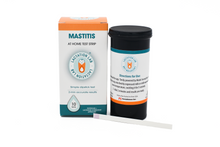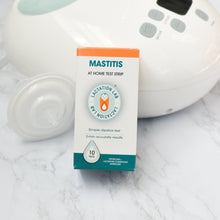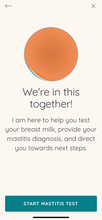
- Easy to use at-home test strip to screen for mastitis.
- A must have for all breastfeeding mothers.
- Know if you need antibiotics to treat infection or not
- Measures LDH enzyme in milk which is secreted at the earliest stages of infection
- To be used with freshly expressed milk
- 10 test strips included
- Use our free Emily's Care app (Apple iOS and Android) to measure LDH levels and recommend next steps
What is Mastitis?
Mastitis is the inflammation of breast tissue usually due to milk not being fully emptied from the breast.
Why test for mastitis?
- 88% of women are prescribed a 10-14 day course of antibiotics to treat their mastitis, when often it can be treated with a shorter course of antibiotics, different feeding positions or further emptying of the breast.
- The overuse of antibiotics results in the presence of antibiotics in your breast milk, which may impact your baby’s gut health.
How to use the Lactation Lab Mastitis Test Strips
- Download our free app, Emily's Care. It will be used to read the test strip.
- Open the app and select Mastitis Test Strip.
- Pump or express your breast milk into a clean baby bottle. Test strip is meant to be used with freshly expressed milk.
- Dip the test strip into the milk for 5 seconds.
- Wait two minutes for the test strip to react to level of LDH present
- The strip will change color, indicating the LDH level. Use the app to take an accurate reading.
- The app will show your results and recommended next steps.
FAQ
What is Mastitis?
Mastitis and engorgement are inflammation related conditions/complications of the breast tissue that are mostly caused by a blocked duct and may be associated with an infection. It is one of the most common problems faced by breastfeeding mothers. Clinical mastitis infections are accompanied with symptoms like pain, swelling or redness that are visible to the naked eye while subclinical mastitis infections do not cause any visible changes making it difficult to detect. If left untreated, symptoms may worsen and lead to the formation of an abscess.
How does the body react to mastitis?
The response of the immune system to inflammation is an increase in the white blood cell count. This defense mechanism is accompanied by a release of several enzymes including lactate dehydrogenase (LDH). The more severe the inflammatory response, the higher the level of this enzyme. LDH concentration in milk has been proven to be an effective marker for tissue breakdown, indicating an active infection. LDH is correlated to total milk cell count, but not as easily affected by other conditions such as stress, nutrition, parity, stage of lactation, etc. LDH levels often rise earlier than white blood cell counts, making it an excellent marker for early detection and screening for breast tissue infections.
How common is Mastitis?
Mastitis can affect up to 40% of breastfeeding women and unfortunately can reoccur.
Who is at risk for Mastitis?
Any woman who is breastfeeding.
I am not nursing and think I have Mastitis. What should I do?
Please contact your care provider right away. This could be an early sign of inflammatory breast cancer.








